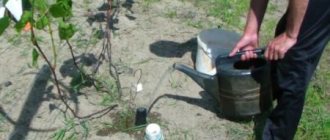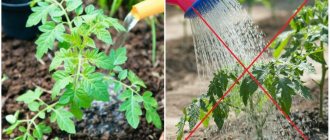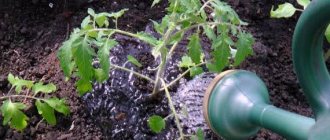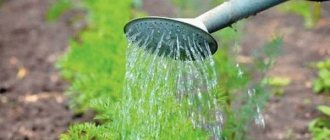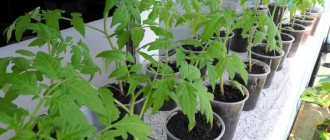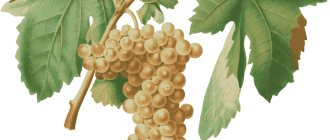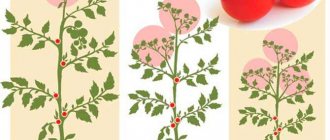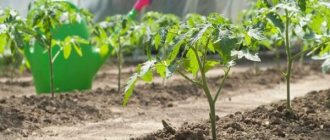When and how to water grapes
To clearly answer all these questions, let’s consider the structure of the root system of a grape bush:
As a rule, the root system of grapes has two or three tiers - the lower one is called the main or heel, the upper one is called dew, the middle tier can be well developed or may be absent altogether, it depends on what kind of seedling the bush was planted with. Some time ago, a popular recommendation was to remove dew roots, supposedly in order to improve the development of the lower tier and give it an advantage. Someone even suggested putting plastic covers on the trunks to prevent the growth of the roots of the upper tier. However, observant winegrowers who tried this agricultural technique soon realized that they were committing great stupidity. The fact is that the lower tier of the root system will always have the advantage that the natural property of polarity gives it. Just as the shoots stretch upward, the plant’s bark system tends to grow downward. There is only one reason that can force a grape bush to weaken the lower root tier in favor of the middle and upper ones - these are unfavorable conditions for the development of roots at depth. It could be anything - too high soil density, salinity, low temperature, etc. In all other cases, heel roots are always more developed than dew or middle roots, and the reason for this is polarity. At the same time, the importance of the roots of the upper and middle tiers should not be underestimated; the upper layers of the soil warm up faster in the spring, they are fertile and receive moisture from rain, here the bush finds more nutrition for itself than at depth. In winter, the upper roots often freeze out, however, this does not lead to the death of the bushes, and during the next season the dew roots grow again.
The second thing you need to understand when answering the question about the importance of watering is that grapes cannot receive nutrition from dry soil; the absorption of mineral elements occurs through the absorption of aqueous solutions of salts. In addition, with a lack of moisture, the plant is forced to limit transpiration by covering the stomata, which simultaneously reduces the consumption of carbon dioxide and reduces the productivity of photosynthesis. Therefore, it is absolutely obvious that in arid regions, watering plays a vital role in grape growing agricultural technology, probably more important than fertilization. Water may be the first factor limiting yield.
Features of seasonal watering
Grape bushes have powerful roots that go deep into the ground. Therefore, they can withstand periods of drought quite steadfastly.
However, proper irrigation helps improve immunity and productivity. Each season has its own requirements for watering grape bushes.
Surface watering of grapes
The first and most obvious is the organization of surface irrigation from a well, a water supply system, or some kind of reservoir using a pump, it does not matter. The simplest method has one drawback - high water consumption, since it is necessary to wet the soil to the entire depth of the root layer, which is approximately 50-60 cm. Watering is usually done in ditches or directly between rows. For newly planted grape bushes, stable watering is very desirable, and it is preferable to water with warm water. Plantings that are 2-3 years old are watered approximately once every two weeks to quickly “accelerate” and enter full fruiting. Adult grape bushes are watered once a month or less. Of course, there are no strict rules here; you need to take into account precipitation, air temperature, and soil type. If there is enough rain in the spring, then additional watering will not be needed, and vice versa, in the July heat it will not be superfluous to carry out a couple of good waterings in a month. On sandy and sandy loam soils it is necessary to water twice as often. In any case, it is preferable to carry out a smaller number of volumetric waterings than to do it often with a small amount of water. 20 liters of water per square meter is the minimum reasonable norm; in case of prolonged drought it should be 3 times higher. Please note that 20 liters per square meter corresponds to a layer of water of only 2 cm.
We calculate water standards depending on the age of the vine
The frequency and technology of watering is determined by the age of the grapevine.
Young seedlings
Only warm water is used to water the seedlings. Pour 2 buckets of water into the hole prepared for planting. It promotes tight adhesion of roots to the soil and initial charging with moisture. The seedling can be placed in the hole only after the liquid is completely absorbed. Then the seedling is watered again with 10 liters of water.
Important! During the first growing season, the norm is to apply 10-15 liters of water once a week.
The roots of young bushes are located within the recess prepared during planting. Therefore, a shallow hole is dug near it, into which water is poured. Its depth should be about 30 cm. The distance from the bush is 30-40 cm. When the moisture is completely absorbed into the soil, the hole is sprinkled. By the end of August, watering stops. Plants need enough moisture from precipitation.
Fruit-bearing vineyards
Fruit-bearing vineyards especially need moisture during the ripening period. They are watered until the fruits begin to soften and acquire a characteristic color. The irrigation rate per 1 m2 is from 50 to 80 liters, depending on the soil structure and weather conditions. If grapes grow in light soil containing sand, the water consumption is greater than for bushes on dense, clay soils. Winegrowers advise determining the amount of watering based on the fact that the soil should be saturated with water to a depth of 1 m.
See also How to make a trellis for grapes with your own hands
old grapes
Old grape bushes react sensitively to drying out soil and need watering at certain periods:
- with the onset of spring, after removing the shelter;
- in May, before and after flowering;
- at the beginning of berry ripening.
Underground (drainage) irrigation of grapes
The picture below shows the principle of underground (drainage) irrigation of grapes, often used by amateur winegrowers. With this method, water flows directly into the zone of the main root system, while the upper layers of the soil remain dry. The obvious advantage of this method is the economical use of water.
Between the bushes along the row line, holes or long ditches 40 cm deep are dug, crushed stone (drainage) is laid at the bottom in a layer of 15-20 cm and irrigation pipes are installed. The crushed stone is covered with film or roofing felt on top so that it does not float under the earth, then the ditch is covered with earth. Thus, watering is carried out in pipes, the water immediately enters the zone of the main root system of the grapes. And everything seems to be beautiful and good, but the top, most fertile layer of soil turns out to be dry. Many people still use this method and are happy with it. Indeed, if the soil on the site is rich, then there are no problems; the grapes will find nutrition at depth. But in general, you should understand that with deep underground irrigation we limit the development of the most fertile soil layer by the roots, and this is a significant drawback of this method.
Vineyard watering methods
For watering and fertilizing grapes, plastic bottles with a cut-off bottom are placed between the seedlings at a distance of 0.5–1 m from the stem itself, a depth of 50–70 cm. For table varieties, as the bushes mature, they are replaced with cuttings of asbestos-cement pipes. A layer of crushed stone is poured from the bottom of the pipe, as well as on the sides, so that the holes do not become clogged. Water can be poured directly into the top end of the pipe or through a hose laid along the row. After three years, the bottles of “techies” (wine varieties) are removed altogether. Mature wine grapes must get their own water from the soil, and the deeper its roots, the better the quality of the wine from its berries.
In recent years, the installation of horizontal pipes has become popular. A horizontal pipe with holes is laid along the row of grapes at a depth of 50–70 cm. Holes for water infiltration should be located at a distance of 0.5–1 m from each other, they are wrapped with mesh or agrofibre to prevent clogging. True, when watering using a horizontal pipe, some bushes may receive less water or not receive it after some of the holes are clogged.
Drip irrigation of grapes
Another method of watering grapes, which is increasingly used by amateurs, is drip. There are two fundamentally different options, both suitable for watering a vineyard - surface and underground. For surface watering, a system of pipes with external droppers distributed throughout the vineyard, or drip tapes, is used. For underground installation, special drip tubes with built-in emitters, protected from soil washing, are used. In this case, the tubes can be buried to a shallow depth, about 10-15 cm, which will ensure uniform moistening of the soil profile to the required depth. Both options have their pros and cons, for example, systems with external drippers allow constant visual monitoring of the operation of the system, and it is possible to simply replace faulty elements. Underground systems allow the tubes to be evenly distributed throughout the area, including between rows, without the risk of mechanical damage. Pipes for underground irrigation can last 10 years or more.
The undoubted advantage of drip irrigation is automation (reduced labor costs), relatively economical consumption of water (due to dosage control) and the ability to organize uniform moistening of a vineyard with differences in elevation. Drip irrigation systems can be built of varying complexity, from simple budget ones with manual control, to systems with timers and the ability to introduce soluble fertilizers into irrigation water. Drip irrigation systems will be discussed in more detail in a separate article.
Autumn irrigation
Watering grapes after flowering, fruiting and harvesting is aimed at providing the best conditions for wintering the bushes. If the soil is very dry in winter, the root system will begin to freeze and then crack. During rainy autumn, additional irrigation will not be required.
Uncovered and covered vineyards are set up for wintering. The first ones are watered after the leaves fall. The latter should be moistened only after work has been done to insulate the vine. This is done before the start of frost in the last weeks of October and the first ten days of November.
There are late varieties of berries. They are often used for long-term storage. Therefore, the end of watering in the fall occurs approximately 30 days before the start of berry picking.
When to water grapes
As mentioned above, watering should be done as needed, taking into account natural precipitation and soil characteristics. I can only give some recommendations on the phases of the growing season, and you need to determine the specific dates yourself, focusing on weather conditions. It is important that the soil is sufficiently moist in the spring. If there was little precipitation in winter, then do not delay and carry out extensive watering immediately after the bushes open. In most regions of our country, such watering will not be necessary, since the soil is usually quite wet in the spring. It is not advisable to water flowering grapes, so if the weather is dry, try to water before flowering begins. If your goal is to grow large, marketable table grapes, then from the setting of the berries until the beginning of their softening, it is advisable to provide stable watering. This agricultural practice is more effective than applying fertilizers when there is a lack of moisture. In order not to delay the ripening of the crop, watering is reduced or even stopped completely during the period of sugar accumulation. Sometimes it is recommended to carry out maintenance watering until the crop ripens; supposedly, a regime of constant soil moisture protects the berries from cracking. I do not support this point of view, since personal experience does not confirm it. In my opinion, cracking of berries is caused by completely different reasons. In late autumn, moisture-recharging volumetric irrigation is carried out. Its purpose is to protect the soil from deep freezing in winter; this agricultural technique is very important and should not be ignored.
Combination of fertilizing and watering
The use of fertilizers will help increase the yield and quality of fruits. It is most necessary to fertilize in the spring. It is in the spring that you need to use mineral and organic fertilizers, as well as add microelements such as zinc, phosphorus and nitrogen. For greater efficiency, they are used in combination with organic mixtures (compost, manure, bird droppings).
In summer, grapes also need to be fed, but those containing nitrogen should be excluded from fertilizers. Organic fertilizers are most favorable for the plant in the hot summer. The latest time for applying fertilizer is 2 weeks before the crop is fully ripened and harvested.
Do not forget about watering when applying fertilizers. It is water that helps fertilizing be better absorbed and promotes the movement of the internal sap of the plant, which carries nutrients to all its parts. Regular watering not only improves immunity, but also improves the vital activity of all plantings and the quality of the resulting harvest, making it sweet and juicy.
Watering grapes of technical varieties
Separately, it is worth mentioning technical vineyards. The technical varieties of grapes themselves also need water like any other, however, their provision with moisture directly affects the condition of the berry juice. Grapes intended for processing into high-quality wines are most often not watered at all. In this case, they do not strive to obtain large berries and large growth of bushes; on the contrary, the goal of the winemaker is to obtain a harvest that is maximally saturated with aromatic substances, phenolic compounds, etc. However, in hot, arid regions, industrial grapes are also watered, the bushes are maintained, and before harvesting, watering is stopped at least a month in advance. Technical vineyards are not only wine, and not always the goal in obtaining high-quality wine; “technical” vineyards can be grown for juices, for processing into flavorings, etc. In any case, the need for irrigation is determined by the soil and climatic conditions of the region, the supply of soil nutrition, the load of the bushes, and the ultimate goal of processing the crop.
Untimely watering is harmful
Half of all water is spent by the plant on filling the berries. Lack of water during this period can have an adverse effect - the berries will harden and stop growing. A minimum of moisture is consumed by the plant during flowering. Approximately 20 percent is spent on shoot growth in the spring; the entire accumulated water supply is consumed before flowering.
25 percent of water is spent on ripening in autumn. In the case of this plant, it is better not to water than to overwater. Excess water during grape growing can cause serious harm.
Watering recommendations
To ensure normal development of the grapevine and good yield, you should follow these simple rules:
- With all the love of the grape bush for moisture, it is better not to allow the soil to become waterlogged.
- Do not allow excessively long intervals between waterings when the soil dries out.
- During periods of excessive growth of green shoots, it is advisable to reduce irrigation.
- There is no need to water the grapes during flowering or on the eve of the start of this process.
- Watering can be increased during dry periods.
- It is better to apply moisture in the evening, when the air and soil temperatures do not differ much.
- Water for irrigation should be taken from rain or pre-settled water.
- After irrigation, the soil is loosened the next day.
Following simple rules and preventing excessive soil moisture or dryness will help ensure the development of the grape bush and excellent yield.
Irrigation methods
There are several ways to water grapes.
Surface
For irrigation, holes or grooves are made, which are located in the root zone of several plants. The grooves should be formed with a depth of at least 20 cm. This option is suitable for small bushes.
This method is not suitable for large bushes with a deep root system, since roots with a depth of 0.5 m or more will be deprived of moisture.
For drip irrigation, a tape is placed at a distance of 20 cm from the trunk. Thanks to this, the bush is provided with the required amount of moisture.
Underground
This method provides the best in-depth hydration. As a result, the risk of damage to the root system from frostbite is minimal. The likelihood of fungal development is reduced.
Along a row of bushes, pipes are placed in the ground at a depth of half a meter. Their diameter is about 10-15 cm. One end of the pipe should be above the soil surface at a height of 15 cm. Holes with a diameter of 12 mm are made in the lower sections of the pipe. To prevent soil penetration, the holes can be wrapped with mesh.
Drainage should be laid at the bottom of the dug trench. Broken brick or crushed stone is used. The part of the pipe that goes to the surface is protected from debris. This method is very economical and allows you to expand the irrigation area.
How to determine moisture deficiency or excess
If the ground is very wet, the following signs can be observed:
- shoots grow quickly;
- after pruning, new stepsons appear within a month, which take a lot of energy and nutrients from the bush, not leaving it for the formation of brushes;
- the growth and filling of berries, and subsequently their ripening, is suspended;
- supposedly ripe berries taste very sour, although they do not differ in color from ripe ones.
The vine formed last year does not ripen and does not become woody.
If the clusters are not dense, the berries are smaller than expected according to the characteristics of the variety, and new shoots grow poorly in the spring, then there is a moisture deficiency in the soil. This occurs if there was little snow in winter and no autumn watering was carried out.
Video: Watering grapes - how to do it right
The value of vegetative irrigation
During the summer drought, vegetation irrigation is carried out. Their main task is to retain moisture in the soil, which promotes the normal development of the bush and its cooling. To understand the advantages of summer watering, you should know the stages of fruit formation.
Grape buds bloom at a temperature of +12°C. When the thermometer reaches +25°C, shoots begin to grow rapidly, and a little later flowers appear on the vine. The optimal temperature for harvest ripening is +30°C. Summer watering at the root improves the absorption of nutrients. Without sufficient moisture, the berries will be significantly smaller. When the temperature begins to drop to +15°C, the grapes will already look ripe. The formation of sugar in the berries stops.
In areas where summer temperatures can reach +40°C, care must be taken to ensure a regular supply of water to the grape bushes. In areas with a temperate climate, grapes do not need frequent and abundant moisture of the soil. Plants should be watered as needed when the soil dries out. If the drought is not severe, the grapes can easily cope with the distribution of liquid. Stem nutrition also includes consumption of leaves. Therefore, in order for the fruits to grow large and sweet, there is no need to save water, because... In hot weather, excess moisture quickly evaporates.

